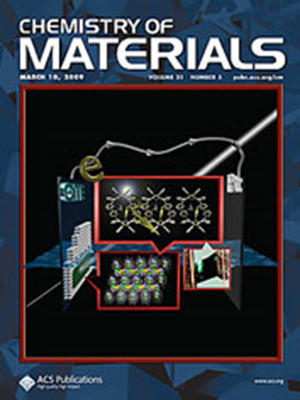侧链极性和对称对无环二氧噻吩聚合物结构和性能的影响
IF 7
2区 材料科学
Q2 CHEMISTRY, PHYSICAL
引用次数: 0
摘要
共轭聚合物上的构象柔性侧链提高了溶液的可加工性,同时显著影响溶液聚集、固态有序和聚合物-电解质相互作用。这些侧链可以强烈地影响重复单元的对称性、极性、空间体积和非共价相互作用,这些相互作用共同决定了聚合物链如何包装和组装。无环二氧噻吩聚合物(PAcDOTs)是一种具有高氧化还原活性的噻吩基有机混合离子电子导体(OMIECs),其中噻吩环的3-和4-位置都被烷氧基取代。在本研究中,我们探索了对称(R1 = R2)和非对称(R1≠R2) PAcDOTs的溶液和固态结构,其中R1和R2都是非极性或两亲性的,我们观察到丰富的工艺结构行为。区域对称侧链和两亲侧链的结合导致氯仿溶液中的手性溶嗜相在薄膜中以亚稳态存在。温度相关的掠入射x射线散射和交叉极化光学显微镜表明,具有区域对称线性侧链的PAcDOTs在热处理后可以结晶成高度有序的形貌。最后,我们证明了侧链极性、对称性和热退火对电化学掺杂和脱掺杂过程的影响。本文章由计算机程序翻译,如有差异,请以英文原文为准。

Impact of Side-Chain Polarity and Symmetry on the Structure and Properties of Acyclic Dioxythiophene Polymers
Conformationally flexible side-chains on conjugated polymers promote solution processability while significantly impacting solution aggregation, solid-state ordering, and polymer–electrolyte interactions. These side-chains can strongly influence the repeat unit symmetry, polarity, steric bulk, and noncovalent interactions that collectively dictate how polymer chains pack and assemble. Acyclic dioxythiophene polymers (PAcDOTs) are highly redox-active thiophene-based organic mixed ionic-electronic conductors (OMIECs) where both the 3- and 4-positions of the thiophene ring are substituted by alkoxy groups. In this study, we explore the solution and solid-state structures of both symmetric (R1 = R2) and asymmetric (R1 ≠ R2) PAcDOTs, where R1 and R2 are both either nonpolar or amphiphilic, and we observe rich process-structure behavior. The combination of regio-symmetric and amphiphilic side-chains results in a chiral, lyotropic phase in chloroform solutions that persists as a metastable state in thin films. Temperature-dependent grazing incidence X-ray scattering and cross-polarized optical microscopy indicate that PAcDOTs with regio-symmetric linear side-chains can crystallize into highly ordered morphologies upon thermal treatment. Finally, we show that side-chain polarity, symmetry, and thermal annealing affect the electrochemical doping and dedoping processes.
求助全文
通过发布文献求助,成功后即可免费获取论文全文。
去求助
来源期刊

Chemistry of Materials
工程技术-材料科学:综合
CiteScore
14.10
自引率
5.80%
发文量
929
审稿时长
1.5 months
期刊介绍:
The journal Chemistry of Materials focuses on publishing original research at the intersection of materials science and chemistry. The studies published in the journal involve chemistry as a prominent component and explore topics such as the design, synthesis, characterization, processing, understanding, and application of functional or potentially functional materials. The journal covers various areas of interest, including inorganic and organic solid-state chemistry, nanomaterials, biomaterials, thin films and polymers, and composite/hybrid materials. The journal particularly seeks papers that highlight the creation or development of innovative materials with novel optical, electrical, magnetic, catalytic, or mechanical properties. It is essential that manuscripts on these topics have a primary focus on the chemistry of materials and represent a significant advancement compared to prior research. Before external reviews are sought, submitted manuscripts undergo a review process by a minimum of two editors to ensure their appropriateness for the journal and the presence of sufficient evidence of a significant advance that will be of broad interest to the materials chemistry community.
 求助内容:
求助内容: 应助结果提醒方式:
应助结果提醒方式:


